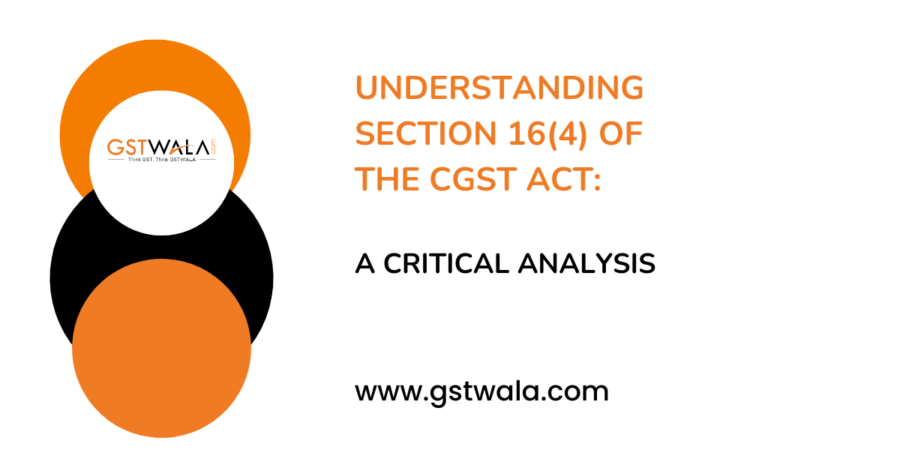
Understanding Section 16(4) of the CGST Act: A Critical Analysis
The implementation of the Goods and Services Tax (GST) Act, 2017 has been a significant milestone in the Indian economy, aiming for economic integration and simplification of the tax structure. However, challenges persist, particularly concerning Section 16(4) of the CGST Act, 2017, which poses burdens for businesses. This article delves into the provisions of Section 16(4) and scrutinizes its validity to address concerns within the business community.
Understanding Section 16 of the CGST Act: Section 16 lays down the eligibility and conditions for availing Input Tax Credit (ITC). It stipulates that every registered person is entitled to claim credit for input tax charged on goods or services used in the course of business, subject to prescribed conditions and restrictions.
Analysis of Section 16(4): Section 16(4) imposes a time constraint on claiming ITC for invoices or debit notes related to goods or services supplied. It mandates that ITC cannot be claimed after the thirtieth day of November following the end of the financial year or furnishing the relevant annual return, whichever is earlier. This provision limits the window for claiming eligible ITC.
Interpretation of Section 16(2) and 16(4): There are debates regarding whether Section 16(2), which starts with a non-obstante clause, overrides Section 16(4). While Section 16(2) lays down conditions for ITC eligibility, including timely compliance, Section 16(4) sets a specific time limit. However, a conjoint reading of the sections suggests that they complement each other rather than conflicting.
Legal Precedents and Interpretation: Various judicial precedents highlight the interpretation of non-obstante clauses and the importance of harmonious construction of statutes. While some argue that Section 16(2) overrides Section 16(4), others emphasize the complementary nature of these provisions. The intent of the legislature appears to ensure proper compliance and prevent misuse of ITC benefits.
Analysis of Case Laws: Court judgments such as Eicher Motors Ltd. vs Union of India and ALD Automotive Pvt. Ltd. vs Commercial Tax Officer emphasize that ITC eligibility is subject to strict compliance with statutory conditions. Mere compliance with Section 16(2) does not confer vested rights on businesses. The analogy drawn with Section 19(11) of the Tamil Nadu Value Added Tax Act, 2006, highlights the distinctiveness of Section 16(4).
Section 16(4) of the CGST Act presents challenges for businesses in claiming Input Tax Credit within stipulated timelines. While interpretations vary, it is essential to ensure compliance with all statutory conditions to safeguard ITC benefits. Harmonious construction of statutes and adherence to legal precedents guide the understanding of Section 16 provisions. Clarifications from legislative authorities may provide further insights into addressing concerns raised by the business community regarding Section 16(4) of the CGST Act.
Top of Form
Argument 2 presented in the provided text highlights several important points regarding the interpretation of Section 16(4) of the CGST Act, 2017, and its implications on the entitlement to input tax credit (ITC). Here’s a breakdown of the key arguments and analysis:
- Interpretation of “Take Credit” Terminology: The argument emphasizes the distinction between being entitled to take credit and actually availing or crediting the credit in the electronic ledger. It emphasizes that the primary source for determining eligibility for ITC is the taxpayer’s books of accounts, and the common portal is merely a facilitator.
- Section 16(1) and Other Sections’ Analysis: The text examines Section 16(1) alongside other relevant sections like Section 41(1) and Section 43A to underscore the process of availing ITC through self-assessment in returns and crediting it to the electronic ledger.
- Role of Books of Accounts: It asserts that the books of accounts serve as the primary material for self-assessment of ITC eligibility, with the electronic credit ledger being secondary.
- Non-Obstante Clause in Section 17(5): The analysis suggests that Section 17(5), which restricts ITC availability in certain cases, does not override Section 16(1)’s enabling provision, implying that compliance with Section 16(2) conditions alone does not guarantee ITC entitlement.
- Procedural Compliance vs. Substantive Right: It argues against procedural lapses depriving taxpayers of their substantive right to claim ITC, citing legal precedents that emphasize protecting substantive rights despite procedural irregularities.
- Interplay Between Sections 16(4) and 16(2)(aa): The text discusses concerns regarding the time limit specified in Section 16(4) and its impact on the provisions of Section 16(2)(aa), highlighting potential issues arising from third-party defaults affecting ITC claims.
- Treatment of ITC in Amnesty Notifications: It examines the treatment of ITC under amnesty notifications issued by the CBIC, arguing that such notifications do not explicitly bar ITC claims, and taxpayers should not be penalized for procedural defaults under Section 16(4).
- Conclusion: The argument concludes by emphasizing that the legislative intent behind Section 16(4) is to ensure timely recording of ITC in books of accounts, rather than depriving taxpayers of their substantive right to claim ITC. It calls for necessary corrective steps or clarifications to prevent undue hardship to taxpayers, especially MSMEs.
Overall, Argument 2 provides a detailed analysis of the interpretation and implications of Section 16(4) in the context of ITC entitlement, highlighting the importance of balancing procedural compliance with safeguarding substantive rights of taxpayers.
For personalized GST solutions tailored to your business needs, reach out to us at info@gstwala.com
